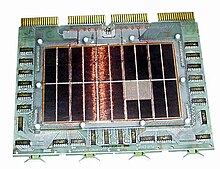Principal memory
Primary memory (MP), main memory, central memory or internal memory is the memory of the computer where both the data and the programs that the central processing unit (CPU) is processing or will process at a certain time are temporarily stored. Due to its function, the MP must be inseparable from the microprocessor or CPU, with whom it communicates through the data bus and the address bus. The width of the bus determines the capacity that the microprocessor has for addressing addresses in memory.
Sometimes called "internal memory" because unlike secondary memory devices, the MP can't be removed as easily.
This kind of memory is volatile, that is to say that when the electrical power is cut, all the information that was stored in it is erased.
MP is the core memory subsystem of a computer system, and has less storage capacity than secondary memory, but millions of times faster speed. The greater the amount of memory, the greater the data storage capacity.
When the CPU has to execute a program, it first places it in memory and then starts executing it. The same is true when you need to process a series of data; before it can process them, it has to bring them into main memory.
Within random access memory (RAM) there is a class of memory called cache memory, which is characterized by being faster than the others, allowing the exchange of information between the CPU and the MP to be faster.
The structure of main memory has changed in the history of computers. Since the 1980s it is predominantly a unit divided into cells that are identified by an address. It is made up of blocks of integrated circuits or chips capable of storing, retaining or "memorizing" information. digital information, ie binary values; these blocks are accessed by the computer's microprocessor.
Types
In computers two types of memories are used:
- Single Reading Memory (Read Only Memory, ROM). It comes from factory with a series of programs. The ROM software is divided into two parts:
- Routine boot or POST (Power On Self Test, “Auto Diagnosis of Encendido”): checks the components of the computer; for example, video control circuits, access to memory, keyboard, disk drives, etc. It is responsible for determining which hardware is present and the computer's pointing. Using a configuration program, the setupread a memory called CMOS RAM (Metalic Oxide Semiconductor). This can keep its content for several years, even if the computer is off, with very little power supplied by a battery, saves the date, time, memory available, hard disk capacity, if it has a disc or not. It is in charge of the next step of starting (booty): read a BR boot log (Boot Record) of the hard drive or other drive (such as CD, USB...), where there is a program that loads the operating system to RAM. Then leave control to that operating system and the computer is ready to work.
- Rutin of the BIOS (Basic Input-Output System or “Basic Entry-Out System”): stays active while using the computer. Allows the activation of the input/output peripherals: keyboard, monitor, mouse, etc.
- Routine Setup: primary stage in which you can modify basic options such as schedule. It is indifferent to the operating system and starts before you log in.
- Reading-writing Memory (Read-Write Memory, RWM): is the memory of the user that temporarily contains the program, the data and the results that are being used by the computer user. In general it is volatile memory, loses its content when the computer is shut down, that is to say that it keeps the data and results as the block receives power supply, except for the CMOS RAM.
Both RAM and ROM are integrated circuits, called chips. The chip is a small tablet of semiconductor material (silicon) that contains multiple integrated circuits, such as transistors, among other electronic devices, with which numerous functions are carried out in computers and electronic devices; that allow, interrupt or increase the flow of current. These chips are on a card or plate.
It is common to mistakenly refer to read/write memory (RWM) as random access memory (RAM), where the type of memory is confused with the way it is accessed.
The content of the memories is nothing more than binary digits or bits (binary digits), which correspond to two logical states: 0 (zero) without electrical charge and 1 (one) with electric charge. Each of these states is called a bit, which is the minimum data storage unit.
The block of MP is usually called RAM, as this is the type of memory chips that make up the block, but it is also associated with the CMOS chip, which stores the system BIOS program, and secondary memory peripheral devices (disks and other peripherals), to make up the computer's memory subsystem.
The CPU addresses the RAM locations in order to access the data stored in them and to place the results of operations.
RWM blocks, ROMs, and flash drives make up the memory subsystem of a computer.
Contenido relacionado
IBM S/360
Triac
Iberia (airline)
